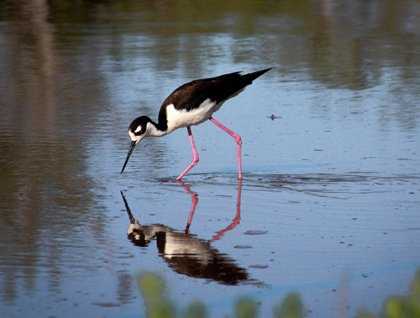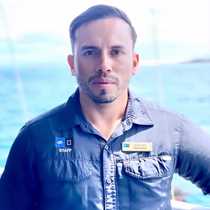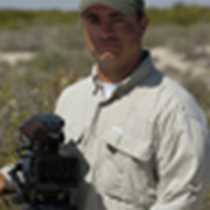Today we navigated towards the uninhabited side of Santa Cruz Island, after having visited the town and the highlands. We woke up to a mix of greenery and arid landscapes alongside our ship. After a dry landing, we hiked inland to a visitor site known as Dragon hill, named for the colossal yellow land iguanas found here. Along the way, we encountered a few birds resting and feeding by the shoreline, including some lava herons, great blue herons, wandering tattlers and common cactus finches. We soon found a brackish water lagoon, full of pintail ducks and a couple of black necked stilts with two little chicks, who allowed us to photograph them as they walked along the grass by the shore. After crossing an incense tree forest, we arrived to the nesting ground of the Galapagos land iguanas, and we spotted plenty of them basking in the middle of the path, while others were feeding on the greenery.
We finished our land expedition of the day, and now we were ready to jump into the refreshing ocean around Guy Fawkes islets, surrounded by open water and amazing marine life. Our snorkeling outing was incredible, and the ocean delivered even more than what we expected. We thought that watching a large variety colorful fish, a white tip reef shark and a green sea turtle was already exciting, but then we had the chance to play with a sea lion in the water, and we were truly surprised by a couple of giant manta rays passing right by us. Just when we thought this excursion couldn’t get any better, we were joined by several Galapagos penguins, who showed up right at the end.
Afterwards, as we returned to the National Geographic Endeavour to enjoy an exotic Ecuadorian lunch, our Expedition leader, Cindy Manning, decided to adjust the day’s itinerary, following our incredible philosophy of being flexible to maximize the endemic experience of our guests. Soon we were on our way to the northern side of Isabela Island to enjoy the views of Wolf Volcano’s eruption, and we could not have expected the amazing show that was in store for us. Wolf Volcano is the highest point in the Galapagos, at 1707 meters high. It was like seeing everything from the beginning again—a large titan at work, erupting large flows of basaltic lava, irrigating the coastline of Isabela with all kinds of red, yellow and purple colors of gases and lava mixing from the water to the air and on land. We had seen this show before from a distance a few days ago, but today we had the best seat in the house, as the National Geographic Endeavour positioned itself about 500 hundred yards away from the lava flowing into the ocean. To add to the experience, our crew set up a whole wine tasting festival on the bow of the ship! There are no words to describe the feeling of having a glass of wine in hand, a camera around your neck, and eyes wide open to enjoy this volcanic show, creating secondary succession for the ecosystem inhabiting Wolf Volcano. Our guests had incredible opportunities for photography, while others just enjoyed the breathtaking show.
Wow! What an INCREDIBLE day we had. From seeing sharks, turtles, penguins, sea lions, birds and iguanas, to all of the sudden the highest volcano in the Galapagos erupting right in front of us, while we enjoy a wine tasting out on deck. Finally, as the cherry on top, we ended the day by crossing the equator line and celebrating.
This was a lot for one day! What a life changing experience.









